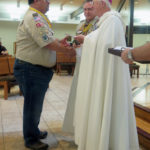By Fr. Bud Grant
What do wildebeest, monarch butterflies, hummingbirds and humpback whales have in common? Here’s a hint: Canada geese belong in that group. Yep, they all engage in annual migrations, mysteries replete with fascinating statistics: the gray whale’s 13,988 miles is the longest migration by a mammal. Among the shortest must be Emperor penguins (about 100 miles), Yellowstone’s elk (65 miles), mountain goats in Glacier (45 miles) and Canadian timber rattlesnakes (5 miles). Sandhill cranes, wood thrushes, mallards, blackpool warbler and whooper swans are among the dozens of bird species that make their way along flyways from Central America to Canada.

Migratory routes are fragile, fractured and fraught with threat. Flying flocks face loss of habitat, light pollution and climate change. Cetacean pods negotiate sound pollution, ghost nets and over harvesting. Land species encounter highways, fences, suburban sprawl … you get the point. Against this, environmentalists are boldly patch-working contiguous migratory passages. One, “Yellowstone to Yukon,” would be the greatest environmental sequestration since the creation of the national parks. Certainly this is as worthy a cause as eminent domaining of Iowa farmland for the Dakota Access Pipeline?
Migrations fascinate us, perhaps because our ancestors were migrants? And maybe our neighbors, too?
Sky-borne chevrons stop us in our own trek from store to parking lot. We point them out to our children in order to bask in the reflection of their unfeigned ardor. The call is that of Jack London’s primordial wildness. Ragged lines of geese remind us of the awesome and ancient cycles of the world around us, and of the coming winter. It is only natural that they twitch us with our own mortality. Such synaptic leaps are as inevitable as poetry.
Ralph Waldo Emerson, in fact, insists that the link between natural events such as migration and the moral and spiritual sentiments inspired by them is intentional. This is to say that we are “hard wired” to draw upon such experiences for our own virtuous enlightenment. He attributes this deep association to the “Universal Spirit,” (evocative of Hegel’s Weldgeist,) a sort of idealist take on the Creator.
Personally, I don’t buy such romantic glosses on natural processes. Jocamo Leopardi makes my point with excruciatingly bluntness in his essay “Dialogo della Natura e di un Islandese,” (1824). His Lady Nature excoriates the Icelander for expecting her to be pleasant: “Did you perhaps imagine that this world was made for you? Or that perhaps in my creations, my laws, and my functions…I intended either human happiness or unhappiness?… even if I were to wipe out your entire species, I would not even be aware of it” (translation mine).
A cold counterpoint to Emerson, whose romantic idealism denies the uncomfortable side of nature “red in tooth and claw” (Tennyson, “In Memoriam”) … its profligate waste of life, its nonchalant disregard for suffering, or its essential requirement that death is the prerequisite to life.
But that last one gives me pause. Jesus himself recognizes the analogy, if not the abject equation: “unless a grain of wheat should fall to the earth and die, it remains but a single grain, but if it dies it bears much fruit.…” Then he adds, with chilling correlation, Anyone who loves their life will lose it, while anyone who hates their life in this world will keep it for eternal life” (Jn. 12: 24-25).
I suspect that if we could make sense out of such parables we will have grasped the essence of the Gospel. When I turn from that passage to the shifting winter-bound honks overhead I realize that, deliberate or not, I am drawn to ponder the “summertime falling down” as Joni Mitchell put it, when, to quote another song, “back to the earth, I feel it. Back to the Earth I’m fallin’” (Rusted Root). Winter is a time of “closing in.” May it be a cloistered time of opening us to the mystery of death …and resurrection.
(Father Bud Grant is a professor of theology at St. Ambrose University in Davenport.)












This is really, REALLY good!
If Barb reads this comment, she will remember me as part of the Arboretum in Clinton. A woman who has been called a tree hugger for more than six decades, although refusing to cut my initials in the playground tree, (even if using my cousin’s pocket knife was a temptation) as it “might make the tree sad!)
I have traveled via many EarthWatch, World Wildlife Federation Road Scholar and Natural Geographic trips to the Monarchs in Mexico and the coast of California, Camino de Santiago, the whales off Baja, and the Leatherbacks in Costa Rica. These were mostly environmental work trips (i.e. relocating the nests of a 1 ton leatherback, full and in labor – eager to deposit her eggs, who had been interrupted in her struggle over the rough beach to begin her nest hole by a tourist who shone a spotlight on her!
I have clearly understood the damage we are doing to this fragile earth (to quote my Book of Common Prayer). I am grateful to Fr. Grant for pointing out very simply other lesson from the Gospel (Can we ever learn enough!)
I do remember you, Francie!Thanks for sharing your memories. We are blessed to have Fr. Bud write a monthly column for us.
moderation?